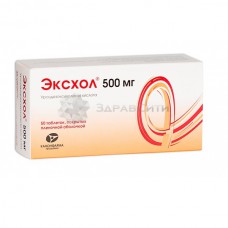Expiration date: 03/2027
Composition:
1 tablet, film-coated, contains:
active substance: ursodeoxycholic acid 500 mg;
excipients: calcium hydrogen phosphate dihydrate 40 mg, calcium stearate 7 mg, carboximetilkrahmal sodium 28 mg, potato starch 33,5 mg mannitol, 58 mg, macrogol (polyethylene glycol 4000) 3.5 mg, povidone K-30 30 mg;
the film composition of the shell: white Opadry 20 mg, including: hypromellose (hydroxypropyl methylcellulose) 6,75 mg hyprolose (hydroxypropyl cellulose) of 6.75 mg, 4 mg talc, titanium dioxide 2.5 mg.
Description: tablets are oval, biconvex scored, film-coated white or almost white.
Pharmacotherapeutic group: hepatoprotective remedy.
Pharmacological action
Pharmacodynamics. Hepatoprotective tool also has choleretic, cholelitolitic, hypolipidemic, hypocholesteremic and some immunomodulatory effects. With high polar properties, ursodeoxycholic acid (UDCA) forms a non-toxic mixed micelles with non-polar (toxic) bile acids, which reduces the ability of gastric reluctate to damage cell membranes in biliary reflux-gastritis and reflux-esophagitis. In addition, UDCA forms double molecules, to be included in the composition of the cell membrane (hepatocytes, cholangiocytes, epithelial cells of the gastrointestinal tract (GIT)), to stabilize them and make them impervious to the action of cytotoxic micelles. Reducing the concentration of toxic to the liver cells of bile acids and stimulating holert, rich in bicarbonates, UDCA effectively contributes to the resolution of intrahepatic cholestasis. Reduces the saturation of bile with cholesterol due to inhibition of its absorption in the intestine and suppressing synthesis in the liver and reduce the secretion into the bile; increases the solubility of cholesterol in bile, forming with it liquid crystals; reduces the lithogenic index of bile. The result is the dissolution of cholesterol gallstones and prevention of formation of new stones. Immunostimulating effect is due to inhibition of expression of HLA antigens-1 on the membranes of hepatocytes and HLA-2 cholangiocyte, normalization of natural killer activity of lymphocytes, etc. Significantly delays the progression of fibrosis in patients with primary biliary cirrhosis, fibrosis and alcoholic steatohepatitis; reduces the risk of developing varicose veins of the esophagus. UDCA slows down the process of premature aging and death of cells (hepatocytes, cholangiocytes, etc.).
Pharmacokinetics. UDCA is absorbed in the small intestine by passive diffusion (about 90 %) and in the ileum by active transport. The maximum concentration in plasma (Cmax) when administered 50 mg 30, 60, 90 min – 3.8 mmol/l, 5.5 mmol/l and 3.7 mmol/l, respectively. Cmax is achieved after 1-3 hours Connection with the plasma protein high – up to 96-99 %. Penetrates through the placental barrier. At regular admission UDCA becomes the major bile acid in serum and constitutes about 48% of the total bile acids in the blood. The therapeutic effect of the drug depends on the concentration of UDCA in bile.
Metabolized in the liver (clearance in the primary passing through the liver) taurine and glycine conjugates. The resulting conjugates are secreted into bile. About 50-70 % of the total dose is excreted in the bile. A small amount is not absorbed UDCA enters the large intestine, where it undergoes cleavage by bacteria (7-dihydroxyflavone); litojolevu acid formed is partially absorbed from the colon, but sulfatides in the liver and rapidly excreted in the form of sulfamethazine or sulfatecontaining conjugate.
Indications for use
- dissolution of small and medium cholesterol stones in a functioning gallbladder;
- biliary reflux-gastritis;
- primary biliary cirrhosis of the liver in the absence of signs of decompensation (symptomatic treatment);
- chronic hepatitis of various Genesis;
- primary sclerosing cholangitis;
- cystic fibrosis (mucoviscidosis);
- non-alcoholic steatohepatitis;
- alcoholic liver disease;
- biliary dyskinesia.
Contraindications
Hypersensitivity to ursodeoxycholic acid or any component of the drug, roentgenologically (high in calcium) gall stones non-functioning gall bladder, acute infectious-inflammatory diseases of the gall bladder, bile ducts and intestines, cirrhosis of the liver decompensation, severe hepatic and/or renal failure, pancreatitis, adults and children with body weight up to 34 kg, children up to age 3 years for this LF.
Use during pregnancy and breastfeeding
The use of the drug Exhol® when pregnancy is possible only in the case when expected benefit for mother exceeds the potential risk to the fetus. Data on the allocation of UDCA in breast milk are not currently available. If necessary, use of the drug during lactation should decide the issue of termination of breastfeeding.
Method of application and doses
Inside, with liquid, squeezed enough water.
The dissolution of cholesterol gallstones
The recommended dose of the drug Exhol® is 10 mg/kg of body weight per day.
The whole daily dose is taken once at night. The course of treatment is 6 - 12 months. For the prevention of recurrent stone formation it is recommended that the drug for a few more months after dissolution of stones.
Treatment of biliary reflux-gastritis.
250 mg per day before bedtime. The course of treatment – from 10-14 days to 6 months, if necessary - up to 2 years.
Symptomatic treatment of primary biliary cirrhosis.
The daily dose depends on body weight and is 10-15 mg/kg/day (if necessary - to 20 mg/kg) in 2-3 doses in the first 3 months of treatment. After the improvement "liver"indicators, the daily dose can be applied once in the evening.
The duration of treatment is not limited. In rare cases, in early may worsen clinical symptoms (increases itching). In this case, you should reduce the daily dose and then gradually increase the dosage (weekly increasing daily dose) until then, until you reach the recommended dosing regimen.
In chronic hepatitis of various Genesis, nonalcoholic steatohepatitis, alcoholic liver disease
Drug Exhol® administered in a daily dose of 10-15 mg ursodeoxycholic acid per 1 kg of body weight, in 2-3 doses, continuously for a long time (6-12 months or more).
Sklerosiruuschem in primary cholangitis and cystic fibrosis (cystic fibrosis)
In primary sklerosiruuschem cholangitis: 12-15 mg/kg/day (20 mg/kg) of body weight per day in 2-3 reception. Duration of treatment – from 6 months to several years. In patients with cystic fibrosis (cystic fibrosis): 20-30 mg/kg per day in 2-3 reception. Duration of treatment – from 6 months to several years.
When biliary dyskinesia
The average daily dose of 10 mg/kg in 2 divided doses for 2 weeks to 2 months. If necessary, the treatment course should be repeated.
In case of impossibility of execution of the dosing regimen is recommended to use pharmaceutical form capsule, Exhal, 250 mg.
Children over 3 years of ursodeoxycholic acid administered individually, at the rate of 10-20 mg/kg/day.


